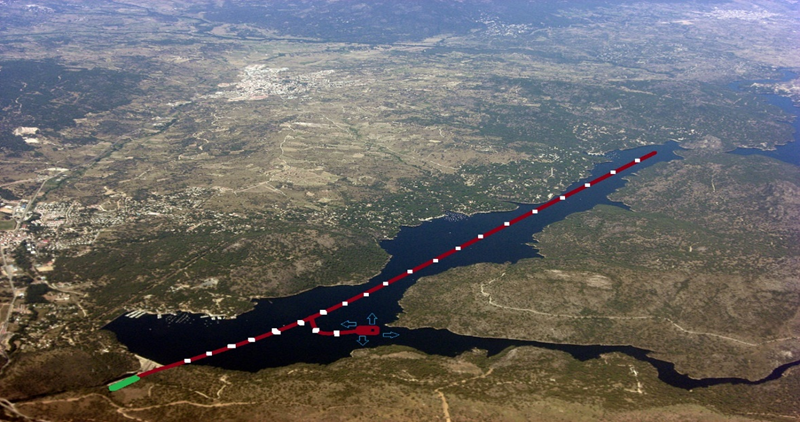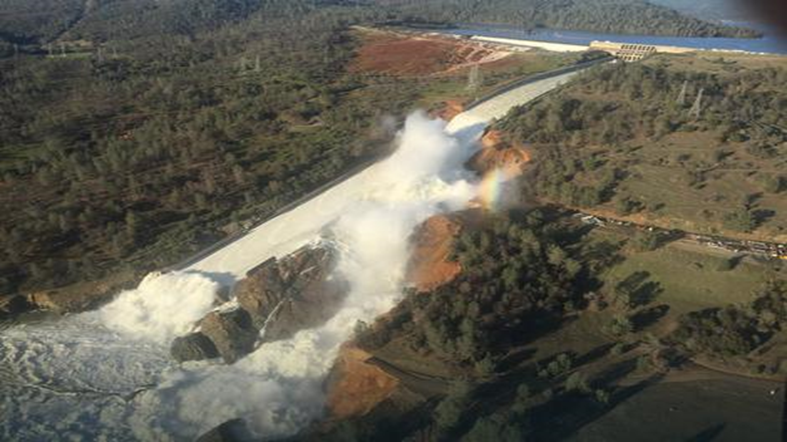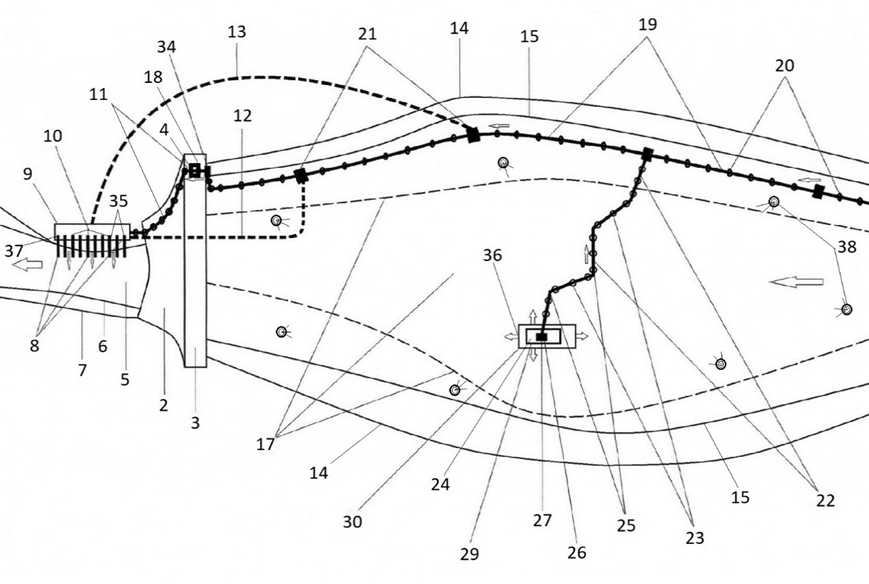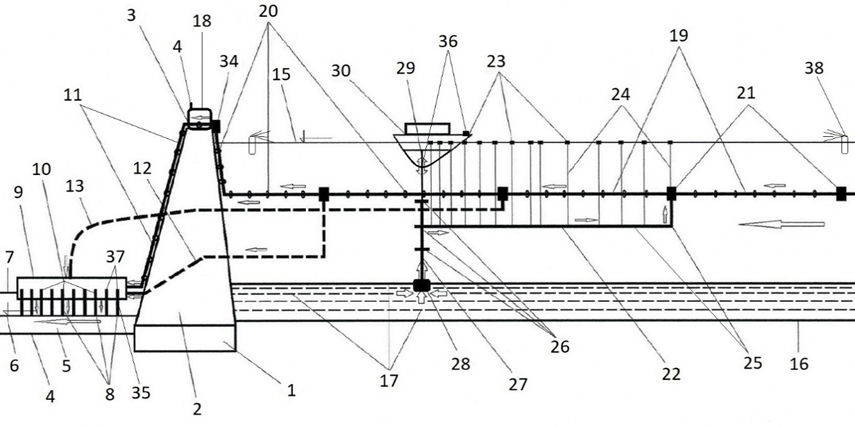Innovative reversible hydro power plant

This is an innovative method of setting up structural elements, which exclusively use the accumulated water from the artificial lake as propulsion energy for the needs of self-cleaning of the consolidated sediment now located at the bottom of the accumulation. In this case, metal pipes are laid along the river bank, below the water surface to the place where the sediment at the bottom of the accumulation is sucked up.
In this case a closed system of interconnected metal pipes was achieved, which were filled with water from the reservoir, they are under pressure to the known difference in height at the water outlet in relation to the level of the reservoir. When we let the water into the river and over the crown of the dam, it starts the sediment from the bottom of the accumulation and sucks it in with the help of vacuum. The work is provided by the well-known physical principle of the connected vessel, where the regulated flow at the water outlet have a tendency to equalize the existing difference in water height in relation to the water level in the reservoir.

The Oroville Dam in California is the tallest dam in America. It collapsed from the water excess from the seasonal rains! The innovation provides the possibility of preventive and useful technical upgrades of the hydroelectric power plant, physical protection of already built dams. The technology, which would be used additionally according to the need and size of the accumulation, would be developed into an innovative process of using reversible hydropower plants.
Accumulations in the world have primarily energy purpose. During their exploitation, problems were observed as a consequence to the backfilling of the reservoir with river sediment, which can endanger the normal functioning of the hydropower plant, and then there would be losing of its useful water volume over time. In the case of hydropower accumulations, reducing the useful water volume is a major problem. Hydropower plants are used to cover excess electricity consumption precisely because of flexible operation. An accumulation lake is essentially a storehouse of potential energy, so it can be used more efficiently if it has projected water storage. Sediment backfill reduces the volume of water in the accumulation, which results in a reduction in energy production in the hydropower plant. The possibility for the production of a hydroelectric power plant during critical periods of electricity consumption is reduced, directly conditioned by time when the electricity consumption is high and the inflow into the accumulation is insufficient.
Today’s extensive analyzes conducted in the world have confirmed that the problem of backfilling reservoirs is extremely complex, that the dynamics of backfilling differs by type of reservoir, and that today’s technological solutions do not provide the necessary quality and cost-effectiveness of overall problem solving. Solutions are being look for in the initial phase of future hydro project planning. Today’s technology is complex, completely inapplicable and economically unjustified, so it is not realized in practice.
With the help of this innovative solution, most of the hydropower plants built in the riverbed can be seen as a source of additional work of the “reversible hydropower plant”, which already has built water storage capacity, then built electricity supply network to consumers. That is, technically, there would already be additional possibilities for the service of depositing surplus electricity from other producers. For example, thermal power plants and nuclear power plants, wind power plants and solar power plants, surplus electricity from night production for future daily consumption. Existing reversible hydropower plants are located outside the riverbeds, formed mainly with separate artificial lakes located in the hills, at higher altitudes.
The innovative reversible hydropower plant has the basic characteristics of the installation:
- the system is an integral part of the hydropower plant (now additional periodic and expensive cleaning of the reservoir is being done, once in several decades) and self-cleaning of the reservoir;
- the system is powered by accumulated water, overflow water resulting from abundant seasonal precipitation is used (now overflow water is not used);
- the process of installation and operation of connected pipe systems requires several times less financial investment than the construction of conventional reversible hydropower plants;
- the innovation inplies that the classic hydropower plants will be reversible hydropower plants (today the existing hydropower plants are an insufficiently used resource for this purpose);
- the entire process of managing the accumulation’s self-cleaning and the operation of the reversible hydropower plant is controlled by employees housed in the engine room, at the hydropower plant itself with the help of technical systems with video surveillance, all accompanied by sonar and other known equipment.
An expert located in the engine room supervises the work process, if necessary, opens additional electricity production by opening the valves on the distributors. In that way, fresh water is captured along the accumulation, which purifies the pipelines. The water has a steady line flow passing through the pipes through the crown of the dam and draws water through the transport pipe for the needs of the generator. With the installation of the pump, the water has the opposite movement, when it fills the accumulation.
The technical solution for the complete removal of already deposited sediments can be stated through the example of a hydroelectric power plant in Serbia. In its forty years of operation, the Đerdap I hydroelectric power plant located on the River Danube with its associated reservoir has deposited an average of over 10 m of sediment, now evenly distributed along the bottom of the reservoir. In the meantime, it has consolidated and as a result has an adverse effect on the protection of the coast, negatively affecting navigation and the ecosystem of the river itself. The severity of the problem is reflected in the fact that at the downstream hydroelectric power plant Đerdap II, we have a situation where only small amounts of sediment, mostly fine particles, pass. The conclusion is that a large part of the sediment from the Danube river basin is stopped and deposited along the accumulation lake of the Đerdap I hydroelectric power plant. The direct effect of this example is such that the process of filling the reservoir continues until the moment when it will significantly affect the possibility of installed electricity production, as well as the use of the waterway.
Today’s technology does not solve the problem with application. With the innovative technology described here, the sediment from the above example is completely solved, and the hydroelectric power plant also received additional new possibilities. The construction of additional MW hydropower plants gives the possibility of alternative generation of electricity with surplus water from flood waves, which have so far been unused by their departure over the dam overflow. Additional installed MW would enable higher daily production of electricity, which is more cost-effective, and which would financially cover the work spent on cleaning the reservoir and building this solution. The conceptual solution provides a direct stimulus for this innovation to be applied in practice with an already built hydroelectric power plant.

With the mentioned example, the upgrade of the accumulation of the Đerdap I Hydroelectric Power Plant at the River Danube, with the application of this solution, can completely solve the problem of the consolidated sediment. A working pipe with an inner diameter of 1.14 m was installed. By the existing oscillation of the accumulation level in relation to the river level, we can get a difference in height that would drive the speed of water flow in the pipes approximately 30 m/s. With the flow surface of the working pipe and the speed of water flow in it, we get an average flow of approximately 30 m³/s, periodic work to remove sediment from the bottom of the reservoir for 24 h. With an innovative system, we can transfer approximately 2,500,000 m³ of water per day. With a water saturation coefficient of 20%, we eject approximately 500,000 m³ of sediment in one day. With this procedure and the intensity of work within 10 days, we can efficiently remove all sediment from the accumulation of Hydroelectric Power Plant Đerdap I, which is now deposited within one year. That is, all the existing consolidated sediment of the reservoir during its forty-year deposition, can be solved by applying the technology within two years. The proposed operation of the plant uses 30 m³/s of running water, which is 0.5% of the current average daily flow of the River Danube.

In this example, a 14 MW generator would be installed in the engine room for system operation. Additionally, for the needs of the operation of the “reversible hydroelectric power plant”, we can install an example of twenty positions with 14 MW = 280 MW. In general, with today’s accumulations, we have paid off the investment in the construction of hydroelectric power plants. They are completely revitalized with this technology with an almost unlimited duration. In combination with the growth of renewable energy sources from the river basin region, it is possible to additionally monitor the time of precipitation and the inflow of water to a certain hydroelectric power plant. In this way, the water from the river flow, driven by surplus electricity from other producers, is transferred and stored in the zone of low water level of the accumulation. Then, the difference between the high waters of the accumulation is supplemented to the maximum by the natural inflow of water from the river, which gives each other the mutual benefit of energy storage. The potential energy of natural water inflow increases when stored at a higher level in the reservoir.
An additional example is the use of the conceptual solution in North America on the Great Lakes, which covers an area of 215,000 km2. Now, under the conditions of global warming, they have a smaller inflow of water, to the already low level of the lake. The current low water level affects the water intake and the use of existing pipelines, disrupting the waterway on the lake itself, connected to land canals. With the innovative technical possibility, we can increase the level of the lake to the necessary and useful level of an additional 4 m. Then we get a storage place for 860,000,000,000 m³ of water, which can be used in time intervals for the future operation of reversible hydropower plants. The working height is approximately 100 m, and the concept applied in this way would have sufficient technical preconditions for the operation of several destinations of MW of future installed generators with pumps.
The river type of innovative reversible hydropower plants is not burdened by the evaporation of stored water, because there is already water that is constantly flowing down the river. There is no drainage of stored water through the land, because the accumulation is in the river flow. The conclusion is that with classic reversible hydropower plants, the water level in the reservoir does not stagnate, it decreases due to evaporation and drainage of water through the soil. In innovative reversible hydropower plants, the water level is constantly increasing due to the inflow of water from the river flow, which gives a better coefficient of use of pumped water by the application of this innovative solution.

